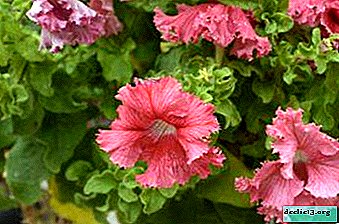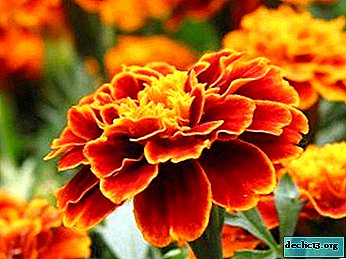Which cacti are generous with flowers? Photos of varieties of Ripsalis and recommendations for home care
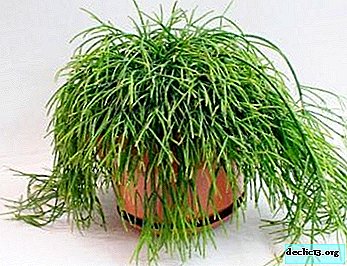
Ripsalis is a spectacular epiphytic plant with an unusual appearance. Perfectly takes root in rooms, is not capricious in leaving and will be liked by any grower. For cultivation, it is enough to follow the basic rules of maintenance.
Even in the same type of ripsalis, the stems are of various shapes - ribbed, rounded, leaf-shaped flattened and various shades of green. They are usually devoid of thorns, branching abundantly, often hanging from trees and rocky ledges.
They have the appearance of whorled, branching, succulent shoots of yellowish-green color, which are wedge-shaped from the base to the apex. These stems have aerial roots that can absorb moisture directly from the air.
Growing Features
In open ground, Ripsalis grows in vast areas of tropical rainforests in Central and South America. Settles on tree trunks or ledges of rocks. Since succulent is used to the tropical climate, in countries where severe frosts occur in winter, the flower is not grown in open ground. It is planted only as an indoor or greenhouse plant.
In the summer, some gardeners take the cactus to the garden and tie it in front of the house. But they make sure that direct sunlight and precipitation do not fall on it, and also spray it with warm water in the morning and evening.Nevertheless, it can be argued that Ripsalis does not require special attention and care - even a beginner grower will cope with home care.
Temperature
 Ripsalis does not like heat and consider the optimum temperature for it to be + 17-24 degrees. If you do not put it under the scorching sun and water it in time, then it will withstand higher temperatures.
Ripsalis does not like heat and consider the optimum temperature for it to be + 17-24 degrees. If you do not put it under the scorching sun and water it in time, then it will withstand higher temperatures.
In winter, the flower is placed in a cool room to slow growth and rest. The temperature in the room should be + 11-15 degrees.
The plant does not tolerate cold well. A critical temperature for him is + 8-10 degrees. If you leave ripsalis in such an environment, it will quickly die.
Watering and humidity
Water the plant moderately but not intensely. Check the need for watering by the level of drying of the soil. To do this, lower a wooden stick into the substrate and look at the surging mud. If the earth has dried out by one third, the flower pot is watered.
In winter, during rest, the frequency and amount of moisture introduced are reduced. If a rest period is not provided, then the intensity of irrigation is the same as in summer.
Ripsalis is sensitive to calcium and chlorine, which are found in tap water a lot, so it is filtered or left to stand for watering for several days.
The flower needs high humidity. To get the necessary moisture, use the following methods:
- Install a household humidifier next to the pot.
- Place the plant on a wide tray with wet expanded clay.
- Spray several times a week from the spray gun.
- Have a warm shower every two weeks.
This is especially important on hot summer days, when the plant suffers from heat.
Lighting
Place the cactus in a room with ambient light. An ideal place is eastern windows. If the window is on the western and southern sides, then from 11 to 16 hours the flower is shaded. In the summer, ripsalis is taken out to the balcony or to the garden, but it is protected from direct sunlight. In winter, additional lighting is installed using fluorescent lamps.
With insufficient light, the color of the stalks pales, they stretch and decorative qualities deteriorate.Pruning
In early March, trimming of ripsalis is carried out.
 The cropping process consists of several steps.:
The cropping process consists of several steps.:
- Inspect the plant.
- Scissors remove old and broken stems.
- Shorten the long old shoots by a third.
- Remove dried inflorescences.
- Break off cuttings for propagation.
Pruning is carried out to activate the growth of new shoots and the formation of a decorative look.
The soil
Cactus soil suitable for neutral acidity, water and breathable. It is made independently. For this, turf and leafy lands, coarse river sand and peat are mixed in equal proportions. Or buy a ready-made mixture for cacti and succulents.
To prevent mold and rot, crushed birch charcoal is added to the substrate.
Top dressing
During the active growth of the flower and to maintain during the formation of buds, fertilizing the plant is carried out with fertilizers once or twice a month. To do this, use mineral complexes for succulents and cacti.
When buying, they look that the composition contains a minimal amount of nitrogen, since its excess contributes to the decay of the roots.And when diluted with water, the dosage of fertilizer is halved as recommended in the instructions. During rest, feeding is stopped.
Transfer
Young ripsalis is transplanted annually, and large and adult specimens every 3-4 years. Perform the procedure after complete flowering in the following sequence:
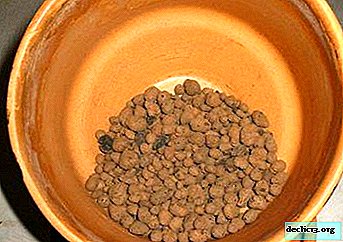 A drainage layer is laid at the bottom of the pot. To do this, use small expanded clay or sea pebbles.
A drainage layer is laid at the bottom of the pot. To do this, use small expanded clay or sea pebbles.- They take the plant out of the old flowerpot and transfer it to a new pot by transfer method. Since the plant has a fragile root system, therefore, when transplanting, you must be as careful as possible. If many small roots break, then the plant will recover for a long time.
- The soil prepared in advance is laid on top, lightly tamped and watered.
When replanting old plants inspect the plant before the procedure, and then rotten and dry roots are removed, the place of cut is sprinkled with activated carbon.
Pot
To plant ripsalis use clay or plastic pots with a suspended structure and an attached tray. The flowerpot should be shallow, but wide. When transplanting into a new container, choose a pot larger in diameter and 2-3 cm in volume.
Wintering
Cactus in winter needs a dormant period. In the fall, watering and fertilizing are gradually reduced. The pot with the plant is transferred to a cool room, with a temperature of 11-15 degrees. Additional lighting is installed in the room.
The plant is watered only when the topsoil is completely dry. Do not put a flowerpot near heating appliances and protect the flower from drafts.
Substrate replacement after purchase
After entering the house, the pot with the plant is sprayed and moderately watered.A few days later, ripsalis is transplanted into a new soil, since often the store substrate is already depleted and does not meet the needs of the flower. Two weeks later, make the first fertilizer. And then they look after them like an ordinary plant.
Conditions for the formation of buds
With the advent of buds, the pot with the plant is transferred from a cool room to a warm place and watering is gradually increased. And also during this period, fertilizing is especially suitable for phosphorus-potassium fertilizers. During flowering, the succulents are not rearranged or rotated, otherwise it drops buds.
Why doesn’t bloom?
If ripsalis does not bloom, then the following conditions are not met.:
- The plant is not provided with a rest period.
- Watering regimen not observed.
- A large amount of fertilizer was introduced.
- Not enough lighting provided.
Photo




It is important to know that not all succulents bloom at home, even with all the rules. It depends on the type of ripsalis (we talked more about varieties and types of ripsalis here). Some bloom every year, others only in adulthood. There are those that do not bloom at all.
Propagation by seeds and cuttings
Ripsalis can be propagated at home, like any other flower. There are two ways to do this:
- Cuttings:
- break off the cuttings from a large adult succulent so that they have a pair of vegetative parts;
- dried during the day and planted in moist loose soil consisting of sand and peat in equal parts;
- with the appearance of the first roots, they are transplanted into a pot with a special soil for succulents and looked after as usual.
- Seeds:
- seed is bought in a store, sown in moist soil and periodically sprayed;
- the seeds germinate quickly, and after the sprouts get stronger they dive into separate containers;
- contain young plants at a temperature of 22-25 degrees.
Major diseases and pests
Ripsalis is usually rarely affected by disease and endures pest attacks.Failure to follow the care instructions may cause some problems.:
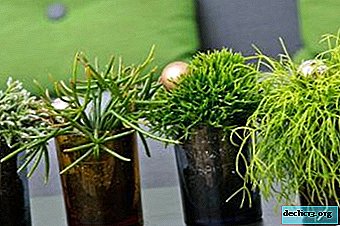 With insufficient lighting, the stems stretch, the green part turns pale, which affects the decorative appearance of the plant. Therefore, the light mode must be monitored.
With insufficient lighting, the stems stretch, the green part turns pale, which affects the decorative appearance of the plant. Therefore, the light mode must be monitored.- When overflowing, the shoots turn yellow and become soft, and the roots rot. The plant is pulled out of the pot, rotted roots are cut and transplanted into a new soil substrate.
- At too low temperatures, the flower drops buds and segments. Cactus rearrange in a warm place.
- The most dangerous pests for ripsalis are mealybug and scale insects. They eat fleshy sheets of succulents, thereby destroying its tissues. In case of slight infection, detractors are washed off with a damp sponge dipped in onion infusion. And when there are a lot of them, then they use the insecticidal preparations Actellik and Fosbetsid. When pests appear, the plant cannot be fertilized and transplanted.
Ripsalis is an amazing plant that has interesting decorative features and is suitable for growing to any grower. It is unpretentious, very rarely sick and does not require much care. It is enough to water and feed on time, and the succulent will delight the owner with its beauty for many years.
Useful video
We offer you to watch a video about the ripsalis cactus:

 A drainage layer is laid at the bottom of the pot. To do this, use small expanded clay or sea pebbles.
A drainage layer is laid at the bottom of the pot. To do this, use small expanded clay or sea pebbles. With insufficient lighting, the stems stretch, the green part turns pale, which affects the decorative appearance of the plant. Therefore, the light mode must be monitored.
With insufficient lighting, the stems stretch, the green part turns pale, which affects the decorative appearance of the plant. Therefore, the light mode must be monitored.


